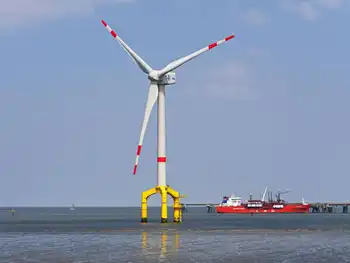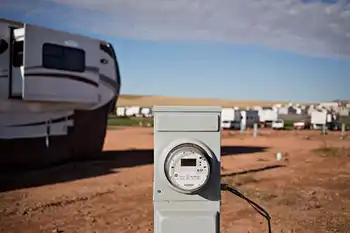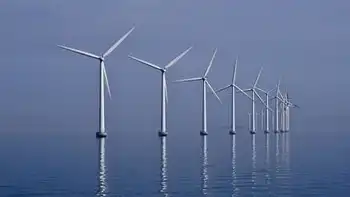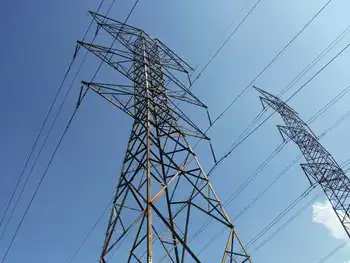Report says wind can power 20 per cent of U.S.
WASHINGTON, D.C. - Wind power is capable of becoming a major contributor to AmericaÂ’s electricity supply over the next three decades, according to a report released by the U.S. Department of Energy.
The groundbreaking report, 20% Wind Energy by 2030: Increasing Wind EnergyÂ’s Contribution to U.S. Electricity Supply, looks closely at one scenario for reaching 20% wind energy by 2030 and contrasts it to a scenario of no new U.S. wind power capacity.
"DOE's wind report is a thorough look at America's wind resource, its industrial capabilities, and future energy prices, and confirms the viability and commercial maturity of wind as a major contributor to America's energy needs, now and in the future," DOE Assistant Secretary of Energy Efficiency and Renewable Energy for the U.S. Department of Energy Andy Karsner, said.
"To dramatically reduce greenhouse gas emissions and enhance our energy security, clean power generation at the gigawatt-scale will be necessary, and will require us to take a comprehensive approach to scaling renewable wind power, streamlining siting and permitting processes, and expanding the domestic wind manufacturing base."
Included in the report are an examination of AmericaÂ’s technological and manufacturing capabilities, the future costs of energy sources, U.S. wind energy resources, and the environmental and economic impacts of wind development. Under the 20% wind scenario, installations of new wind power capacity would increase to more than 16,000 megawatts per year by 2018, and continue at that rate through 2030.
“The report shows that wind power can provide 20% of the nation’s electricity by 2030, and be a critical part of the solution to global warming,” said AWEA Executive Director Randall Swisher. “This level of wind power is the equivalent of taking 140 million cars off the road,” he said. “The report identifies the central constraints to achieving 20% - transmission, siting, manufacturing and technology - and demonstrates how each can be overcome. As an inexhaustible domestic resource, wind strengthens our energy security, improves the quality of the air we breathe, slows climate change, and revitalizes rural communities.”
The report finds that achieving a 20 percent wind contribution to U.S. electricity supply would:
• Reduce carbon dioxide emissions from electricity generation by 25 percent in 2030;
• Reduce natural gas use by 11%;
• Reduce water consumption associated with electricity generation by 4 trillion gallons by 2030;
• Increase annual revenues to local communities to more than $1.5 billion by 2030; and
• Support roughly 500,000 jobs in the U.S., with an average of more than 150,000 workers directly employed by the wind industry.
At 20% of electric power generation, significant growth in the manufacturing supply chain would create jobs and remedy the current shortage in parts for wind turbines.
Reducing the use of natural gas could save money for consumers due to the resulting downward pressure on the price of natural gas, according to AWEA.
"The report correctly highlights that greater penetration of renewable sources of energy - such as wind - into our electric grid will have to be paired with not only advanced integration technologies but also new transmission," DOE's Assistant Secretary for Electricity Delivery and Energy Reliability Kevin Kolevar said. "In many cases, the most robust sources of renewable resources are located in remote areas, and if we want to be able to deliver these new clean and abundant sources of energy to population centers, we will need additional transmission."
“We must look at meeting future electric demands in a cost-effective way,” said Suedeen Kelly, FERC Commissioner. “The 20% wind scenario would only cost 2 percent more than the cost of the baseline scenario without wind. At 50 cents per month for the average ratepayer, that is a small price to pay for the climate, water, natural gas, and energy security benefits it would buy - and it does not even count the stability provided to consumers by eliminating fuel price risk.”
“Though economic and other factors will ultimately determine our energy future, we believe the 20 percent wind scenario is feasible, but only with a major national transmission highway system. Delivering power from the best windy regions to the growing urban supply requires a bigger, stronger transmission system. Strong regional and interregional planning as well as broad allocation of costs will allow the United States to rely on a broader diversity of generation resources," said Mike Heyeck, Senior VP of AEP Transmission.
The report comes at an important time in wind development. In 2007, wind was one of the fastest growing sources of electricity in the nation, second only to natural gas for the third consecutive year. According to an AWEA report released last week, the U.S. wind energy industry continued new installations at a breakneck pace in the first quarter of 2008, putting 1,400 megawatts (MW) or approximately $3 billion worth of new generating capacity in place - enough to serve the equivalent of 400,000 homes - coupled with investment in 17 new manufacturing facilities over the past year.
“Wind is an important part of BP Alternative Energy’s business and of BP’s diverse energy portfolio. Siting and wildlife issues will be a challenge, but AWEA and industry leaders are committed to working with stakeholders to make wind the environmental electricity choice,” said Bob Lukefahr, President, Power Americas, BP Alternative Energy North America. “This report underscores the benefits of diversifying our electricity sources. Growing to 20% wind requires investment in new manufacturing and capital projects, an estimated 500,000 jobs, and brings rural economic development across the country.”
In 2006, President Bush articulated a national imperative for greater energy efficiency and a more diversified energy portfolio. Citing wind energy as part of the solution, he noted that areas of the nation with good wind resources could satisfy up to 20 percent of AmericaÂ’s total electricity demand.
Subsequently, government and industry came together to thoroughly explore the feasibility of generating 20 percent of U.S. electricity from wind by 2030 and produced this joint report to aid policy-makers and the public in better understanding the issues, investments, and likely outcomes associated with pursuing this objective.
Related News
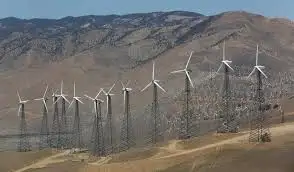
Tunisia invests in major wind farm as part of longterm renewable energy plan
TUNIS - UPC Renewables (UPC) and the Climate Fund Managers (CFM) have partnered to develop a 30 megawatt wind farm in Sidi Mansour, Tunisia that will help the country meet its 30% renewable energy target by 2030.
Tunisia announced the launch of its solar energy plan in 2016, aiming to increase the role of renewables in its electricity generation mix ten-fold to 30%,
This Sidi Mansour Project will help Tunisia meet its goals, reducing its reliance on imported fossil fuels and demonstrating to the world that it is serious about further development of renewable energy investment.
“Chams Enfidha”, the first solar energy station…

